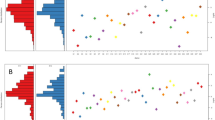Abstract
OBJECTIVE: To evaluate testing practices and perceptions of HIV risk among a geographically diverse, population-based sample of sexually active adults who reported behaviors that could transmit HIV.
DESIGN: Secondary analysis of the Centers for Disease Control and Preventions Behavioral Risk Factor Surveillance System (BRFSS) 2000 survey.
PATIENTS/PARTICIPANTS: Sexually active adults less than 50 years old, who completed the Sexual Behavior Module of the BRFSS 2000 survey administered in 4 U.S. states.
MEASUREMENTS AND MAIN RESULTS: Nineteen percent of the study population reported one or more behaviors in the past year that increased their risk of HIV infection (men 23%; women 15%). In this subgroup at any increased risk of HIV infection, 49% reported having had an HIV test in the past year. For 71% of those tested, the HIV test was self-initiated. Younger age was the only factor independently associated with whether or not individuals with behaviors that increased their risk of HIV infection had had a recent HIV test. Among the 51% of individuals at risk who reported no recent HIV test, 84% perceived their risk as low or none.
CONCLUSIONS: In this study, about half of the individuals who reported behaviors that could transmit HIV had not been recently tested for HIV. Of those not tested, most considered their risk of HIV to be low or none. Interventions to expand HIV testing and increase awareness of HIV risk appear to be needed to increase early detection of HIV infection and to reduce its spread.
Similar content being viewed by others
References
Holtgrave DR. Estimation of annual HIV transmission rates in the United States, 1978–2000. J Acquir Immune Defic Syndr. 2004;35:89–92.
Karon JM, Fleming PL, Steketee RW, De Cock KM. HIV in the United States at the turn of the century: an epidemic in transition. Am J Public Health. 2001;91:1060–8.
Centers for Disease C, Author: Prevention. Increases in HIV diagnoses—29 States, 1999–2002. MMWR. 2003;52:1145–8.
Wolitski RJ, MacGowan RJ, Higgins DL, Jorgensen CM. The effects of HIV counseling and testing on risk-related practices and help-seeking behavior. AIDS Educ Prevent. 1997;9(3 S):52–67.
Weinhardt LS, Carey MP, Johnson BT, Bickham NL. Effects of HIV counseling and testing on sexual risk behavior: a meta-analytic review of published research, 1985–1997 [see comment]. Am J Public Health. 1999;89:1397–405.
Anonymous. Adoption of protective behaviors among persons with recent HIV infection and diagnosis—Alabama, New Jersey, and Tennessee, 1997–1998. MMWR. 2000;49:512–5.
Carpenter CC, Cooper DA, Fischl MA, et al. Antiretroviral therapy in adults: updated recommendations of the International AIDS Society-USA Panel. JAMA. 2000;283:381–90.
Valdiserri RO, Holtgrave DR, West GR. Promoting early HIV diagnosis and entry into care. AIDS. 1999;13:2317–30.
Force USPST. Guide to Clinical Preventive Services: Report of the U.S. Preventive Services Task Force. 2nd ed. Baltimore, Md: Williams & Wilkins; 1996.
Centers for Disease C, Prevention. Revised guidelines for HIV counseling, testing, and referral. MMWR. Recommendations & Reports. 2001;50(RR-19):1–57; quiz CE1-19a1-CE6-19a1.
Centers for Disease C, Prevention. (U.S. Department of Health and Human Services). HIV Prevention Strategic Plan Through 2005. 2001.
Centers for Disease C, Prevention. HIV/AIDS Surveillance Report. 2002. Report No.: 14.
Holtzman D, Bland SD, Lansky A, Mack KA. HIV-related behaviors and perceptions among adults in 25 states: 1997 Behavioral Risk Factor Surveillance System. Am J Public Health. 2001;91:1882–8.
Catania JA, Gibson DR, Chitwood DD, Coates TJ. Methodological problems in AIDS behavioral research: influences on measurement error and participation bias in studies of sexual behavior. Psychol Bull. 1990;108:339–62.
Berrios DC, Hearst N, Coates TJ, et al. HIV antibody testing among those at risk for infection. The National AIDS Behavioral Surveys. JAMA. 1993;270:1576–80.
Anderson JE, Carey JW, Taveras S. HIV testing among the general US population and persons at increased risk: information from national surveys, 1987–1996. Am J Public Health. 2000;90:1089–95.
Valdiserri RO, Weber JT, Frey R. Trends in HIV seropositivity in publicly funded HIV counseling and testing programs: implications for prevention policy. Am J Prev Med. 1998;14:31–42.
Prevention CfDCa. (Centers for Disease Control and Prevention). HIV Counseling and Testing in Publicly Funded Sites Annual Report 1997 and 1998. 2001.
Epstein RM, Morse DS, Frankel RM, Frarey L, Anderson K, Beckman HB. Awkward moments in patient-physician communication about HIV risk. Ann Intern Med. 1998;128:435–42.
Wenrich MD, Curtis JR, Carline JD, Paauw DS, Ramsey PG. HIV risk screening in the primary care setting. Assessment of physicians skills [see comment]. J Gen Intern Med. 1997;12:107–13.
Author information
Authors and Affiliations
Corresponding author
Additional information
The authors have no conflicts of interest to report.
This study was supported by the Northwest VA Seattle Epidemiologic Research and Information Center (ERIC) and the Northwest Center of Excellence of Health Services Research and Development. Dr. Takahashi and Dr. Johnson are staff physicians at the VA Puget Sound Health Care System, and Dr. Takahashi is currently supported by the National Institute on Drug Abuse (NIDA #RO3DA14518). Dr. Bradley is an investigator at the VA Puget Sound Health Care System and is currently supported by the National Institute of Alcohol Abuse and Alcoholism (NIAAA #K23AA00313) and was a Robert Wood Johnson Foundation Generalist Physician Faculty Scholar at the time this study was conducted. This study was presented as a poster at the Society of General Internal Medicine Annual Meeting, Vancouver, British Columbia, April 30–May 3, 2003. We thank Freya Spielberg, MD, MPH for her critical review of the manuscript.
Rights and permissions
About this article
Cite this article
Takahashi, T.A., Johnson, K.M. & Bradley, K.A. A population-based study of HIV testing practices and perceptions in 4 U.S. states. J GEN INTERN MED 20, 618–622 (2005). https://doi.org/10.1111/j.1525-1497.2005.0112.x
Received:
Accepted:
Issue Date:
DOI: https://doi.org/10.1111/j.1525-1497.2005.0112.x




